
Concept explainers
Consider dimensionless velocity distribution in Couette flow (which is also called generalized Couette flow) with an applied pressure gradient which is obtained in the following from in Example 9-16 as
where
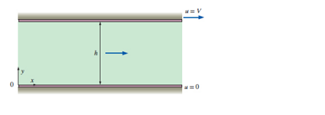
FIGURE P9-102
(a)
The velocity distribution is a superposition of Couette flow with a linear velocity distribution and Poiseuille flow with a parabolic velocity distribution.
Explanation of Solution
Given information:
The following figure shows that two infinite plates.
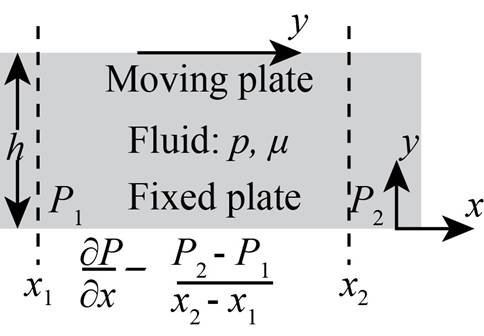
Figure-(1)
At the point of wall and fluid, the velocity of the fluid is equal to zero.
Write the expression for the pressure gradient.
Here, the arbitrary locations along the
Write the expression for
Here, the viscosity is
Write the expression for
Here, the density of the fluid is
Integrate Equation (II) with respect to
Here, the constant is
Integrate Equation (IV) with respect to
Here, the constant is
Integrate Equation (III) with respect to
Here, the constant is
The following figure represents planar Poiseuile flow.
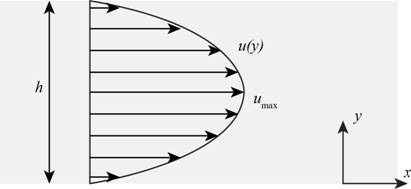
Figure (2)
Write the expression for dimensionless form of velocity field.
Here, the non- dimensional velocity along the arbitrary location along the
The Equation (VII) indicates that the pressure gradient is positive. If the both walls are stationary and pressure gradient is also there, then the flow should be planar Poiseuile flow.
Write the expression for non- dimensional velocity.
Write the expression for non- dimensional pressure.
Write the expression for non -dimensional distance
Calculation:
Substitute
Substitute
Substitute
The Equations (VII) indicates super position of the linear velocity profile
Substitute
(b)
The plot the
Answer to Problem 102P
The following Figure (4) represents the
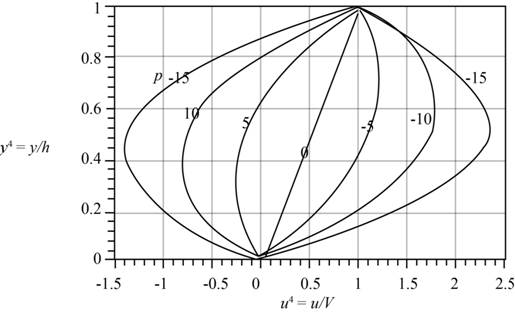
Explanation of Solution
At the point of wall and fluid, the velocity of the fluid is equal to zero.
Write the expression for the pressure gradient.
Here, the arbitrary locations along the
The following figure represents planar Poiseuile flow.
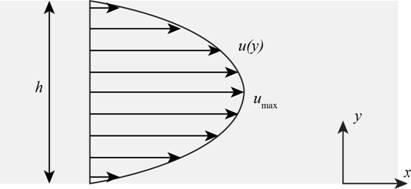
Figure (2)
Write the expression for dimensionless form of velocity field.
Here, the non dimensional velocities is
The Equation (VII) indicates that the pressure gradient is positive. If the both walls are stationary and pressure gradient is also there, then the flow should be planar Poiseuile flow.
Write the expression for non -dimensional velocity.
Write the expression for non -dimensional pressure.
The following figure represents the Couette flow between two parallel plates.
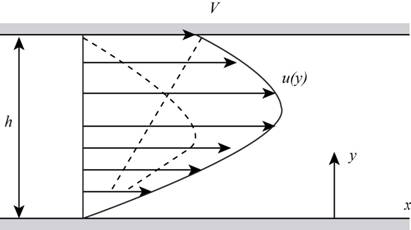
Figure-(3)
The pressure gradient is less than two, then pressure is decreasing in
Write the expression for non dimensional distance
Substitute
The following table represents the pressure gradient and x or y non- dimensional distance.
| | | |
| | | |
| | | |
| | | |
The following figure represents between
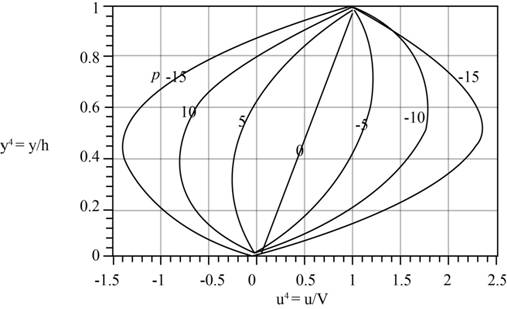
Figure (4)
The Figure (4) indicates that the pressure gradient is positive. If the both walls are stationary and pressure gradient is also there, then the flow should be planar Poiseuile flow.
Conclusion:
The following Figure (4) represents the
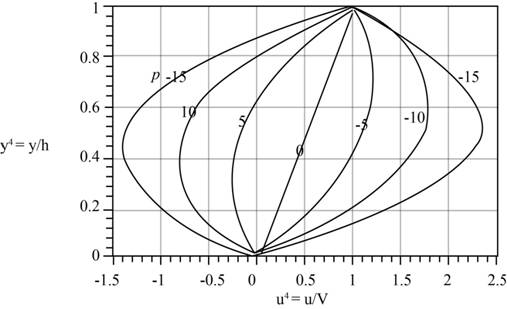
(c)
The position and magnitude of maximum dimensionless velocity.
Answer to Problem 102P
The expression for the pressure of fluid 1 is
The expression for the pressure of fluid
Explanation of Solution
Assume, at the point of wall and fluid, the velocity of the fluid is equal to zero.
Write the expression for velocity of the fluid 1,
Here, the velocity of fluid 1 is
Assume, the velocity of the fluid 2 at the free surface of the wall is equal to the velocity of the moving plates.
Write the expressions for the velocity of fluid 2.
Here, the velocity of fluid 2 is
Write the expression for velocity at interface.
Write the expression for rate of shear stress.
Here, the kinematic coefficient of fluid is
Write the expression for the shear stress acting on fluid
Here, the kinematic coefficient of fluid 1 is
Write the expression for the shear stress acting on fluid 2.
Here, the kinematic coefficient of fluid 2 is
Write the expression for the rate of shear stress at interface.
Write the expression for pressure at the bottom of the flow,
Here, the pressure is
Write the expression for the pressure at the interface of fluid 1.
Here, the pressure at the fluid 1 is
Write the expression for the pressure at the interface of fluid 2.
Here, the pressure at the fluid 1 is
At the interface of the fluid the pressure cannot have discontinuity and the surface is ignored.
Write the expression for the pressure at interface of fluid.
Here, the velocity of flow for fluid
Write the expression for
Here, the density of the fluid 1 is
Write the expression for
Here, the density of the fluid 2 is
Calculation:
Integrate Equation (XXVII) with respect to
Here, the constant is
Substitute
Substitute
Integrate Equation (XXVIII) with respect to
Here, the constant is
Substitute
Substitute
Substitute
Conclusion:
The expression for the pressure of fluid 1 is
The expression for the pressure of fluid 2 is
(d)
The position and magnitude of the maximum dimensionless velocity.
Answer to Problem 102P
The position of the maximum dimensionless velocity is
The magnitude of the maximum dimensionless velocity is
Explanation of Solution
Given information:
Write the expression for the position of the velocity.
Here, the viscosity of the fluid is
The following figure represents positions of the velocities.
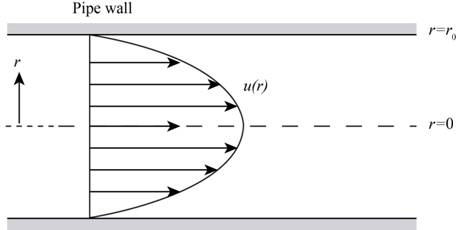
Figure-(5)
Write the expression for the radial velocity
Here, the maximum velocity is
The following figure represents the magnitude of the velocity.
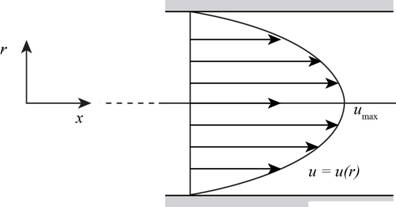
Figure-(6)
Write the expression for magnitude.
Here the magnitude is
Substitute
Conclusion:
The position of the maximum dimensionless velocity is
The magnitude of the maximum dimensionless velocity is
Want to see more full solutions like this?
Chapter 9 Solutions
Fluid Mechanics: Fundamentals and Applications
- Sketch and describe hatch coamings. Describe structrual requirements to deck plating to compensate discontinuity for corners of a hatch. Show what is done to the deck plating when the decks are cut away and include the supporting members.arrow_forwardAn Inclining experiment done on a ship thats 6500 t, a mass of 30t was moved 6.0 m transvesly causing a 30 cm deflection in a 6m pendulum, calculate the transverse meta centre height.arrow_forwarda ship 150 m long and 20.5 m beam floats at a draught of8 m and displaces 19 500 tonne. The TPC is 26.5 and midshipsection area coefficient 0.94. Calculate the block, prismatic andwaterplane area coefficients.arrow_forward
- A vessel loads 680 t fuel between forward and aft deep tanks. centre of gravity of forward tank is 24m forward of ships COG. centre to centre between tanks is 42 m. how much in each tank to keep trim the samearrow_forwardBeam of a vessel is 11% its length. Cw =0.72. When floating in SW of relative denisity 1.03, TPC is 0.35t greater than in freshwater. Find the length of the shiparrow_forwardAn inclining experiment was carried out on a ship of 4000tonne displacement, when masses of 6 tonne were moved transverselythrough 13.5 m. The deflections of a 7.5 m pendulurnwere 81, 78, 85, 83, 79, 82, 84 and 80 mm respectively.Caiculate the metacentric height.arrow_forward
- A ship of 10 000 tonne displacement has a waterplanearea of 1300 m2. The ship loads in water of 1.010 t/m3 andmoves into water of 1.026 t/m3. Find the change in meandraughtarrow_forwardA ship of 7000 tonne displacement has a waterplane areaof 1500 m2. In passing from sea water into river water of1005 kg/m3 there is an increase in draught of 10 cm. Find the Idensity of the sea water.arrow_forwardA ship has 300 tonne of cargo in the hold, 24 m forward ofmidships. The displacement of the vessel is 6000 tonne and its centre of gravity is 1.2 m forward of midships.Find the new position of the centre of gravity if this cargo ismoved to an after hold, 40 m from midshipsarrow_forward
- Sketch and describe how ships are supported in dry dock. When and where does the greatest amount of stresses occur?arrow_forwardSketch and desribe a balanced rudder and how it is suspendedarrow_forwardA ship 140 m long and 18 m beam floats at a draught of9 m. The immersed cross-sectionai areas at equai intervais are 5,60, 116, 145, 152, 153, 153, 151, 142, 85 and 0 m2 respectively.Calculate:(a) displacement(b) block coefficient(c) midship section area coefficient(d) prismatic coefficient.arrow_forward
 Elements Of ElectromagneticsMechanical EngineeringISBN:9780190698614Author:Sadiku, Matthew N. O.Publisher:Oxford University Press
Elements Of ElectromagneticsMechanical EngineeringISBN:9780190698614Author:Sadiku, Matthew N. O.Publisher:Oxford University Press Mechanics of Materials (10th Edition)Mechanical EngineeringISBN:9780134319650Author:Russell C. HibbelerPublisher:PEARSON
Mechanics of Materials (10th Edition)Mechanical EngineeringISBN:9780134319650Author:Russell C. HibbelerPublisher:PEARSON Thermodynamics: An Engineering ApproachMechanical EngineeringISBN:9781259822674Author:Yunus A. Cengel Dr., Michael A. BolesPublisher:McGraw-Hill Education
Thermodynamics: An Engineering ApproachMechanical EngineeringISBN:9781259822674Author:Yunus A. Cengel Dr., Michael A. BolesPublisher:McGraw-Hill Education Control Systems EngineeringMechanical EngineeringISBN:9781118170519Author:Norman S. NisePublisher:WILEY
Control Systems EngineeringMechanical EngineeringISBN:9781118170519Author:Norman S. NisePublisher:WILEY Mechanics of Materials (MindTap Course List)Mechanical EngineeringISBN:9781337093347Author:Barry J. Goodno, James M. GerePublisher:Cengage Learning
Mechanics of Materials (MindTap Course List)Mechanical EngineeringISBN:9781337093347Author:Barry J. Goodno, James M. GerePublisher:Cengage Learning Engineering Mechanics: StaticsMechanical EngineeringISBN:9781118807330Author:James L. Meriam, L. G. Kraige, J. N. BoltonPublisher:WILEY
Engineering Mechanics: StaticsMechanical EngineeringISBN:9781118807330Author:James L. Meriam, L. G. Kraige, J. N. BoltonPublisher:WILEY





